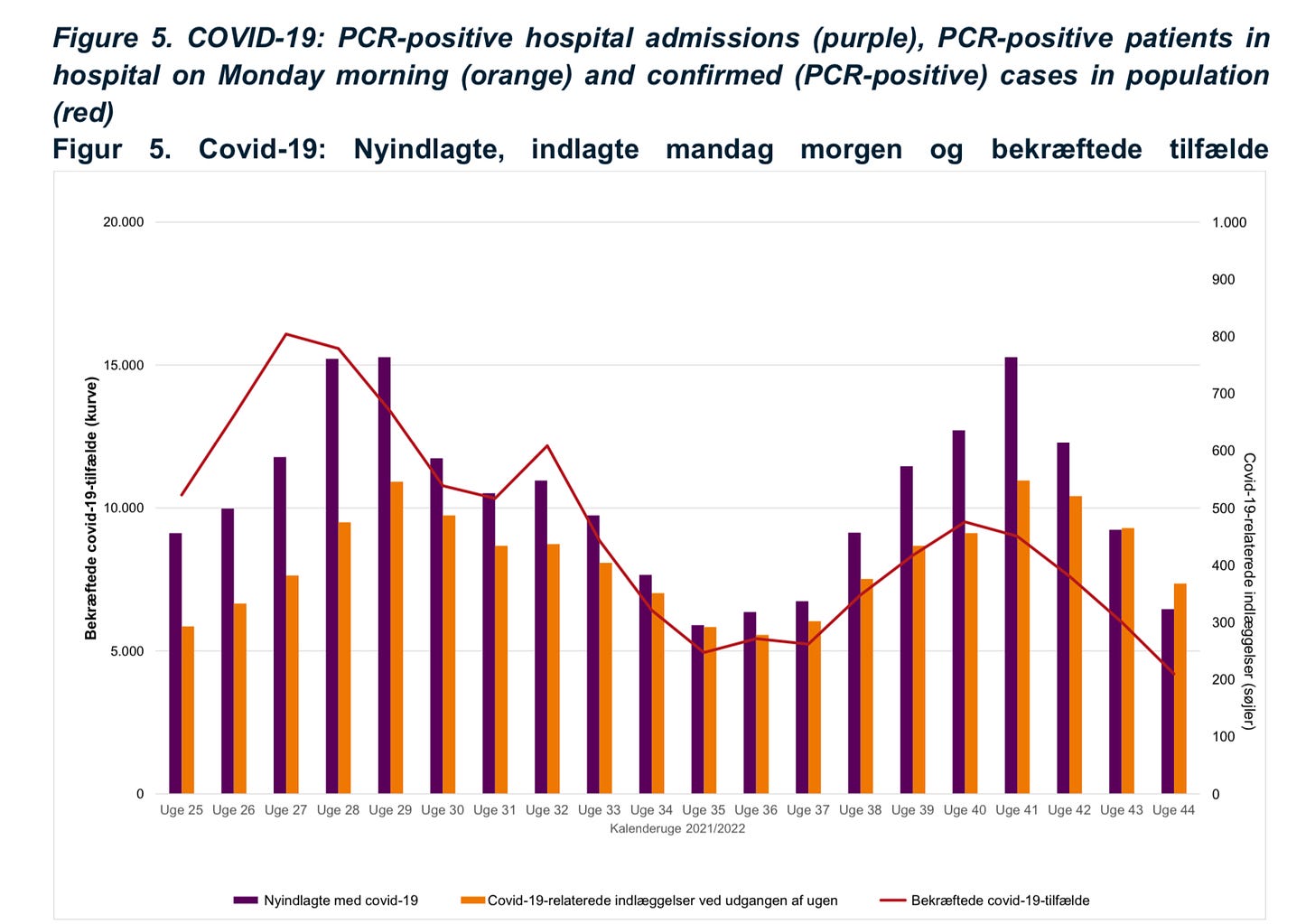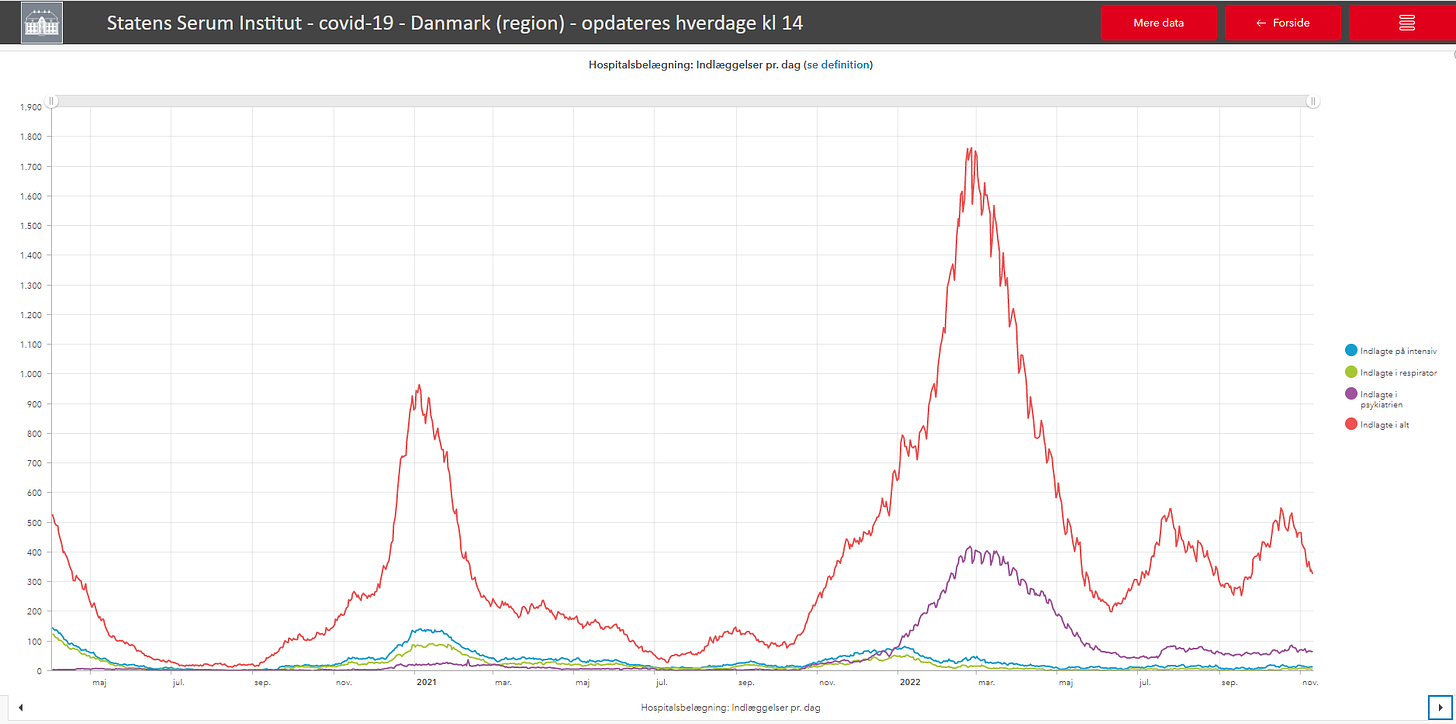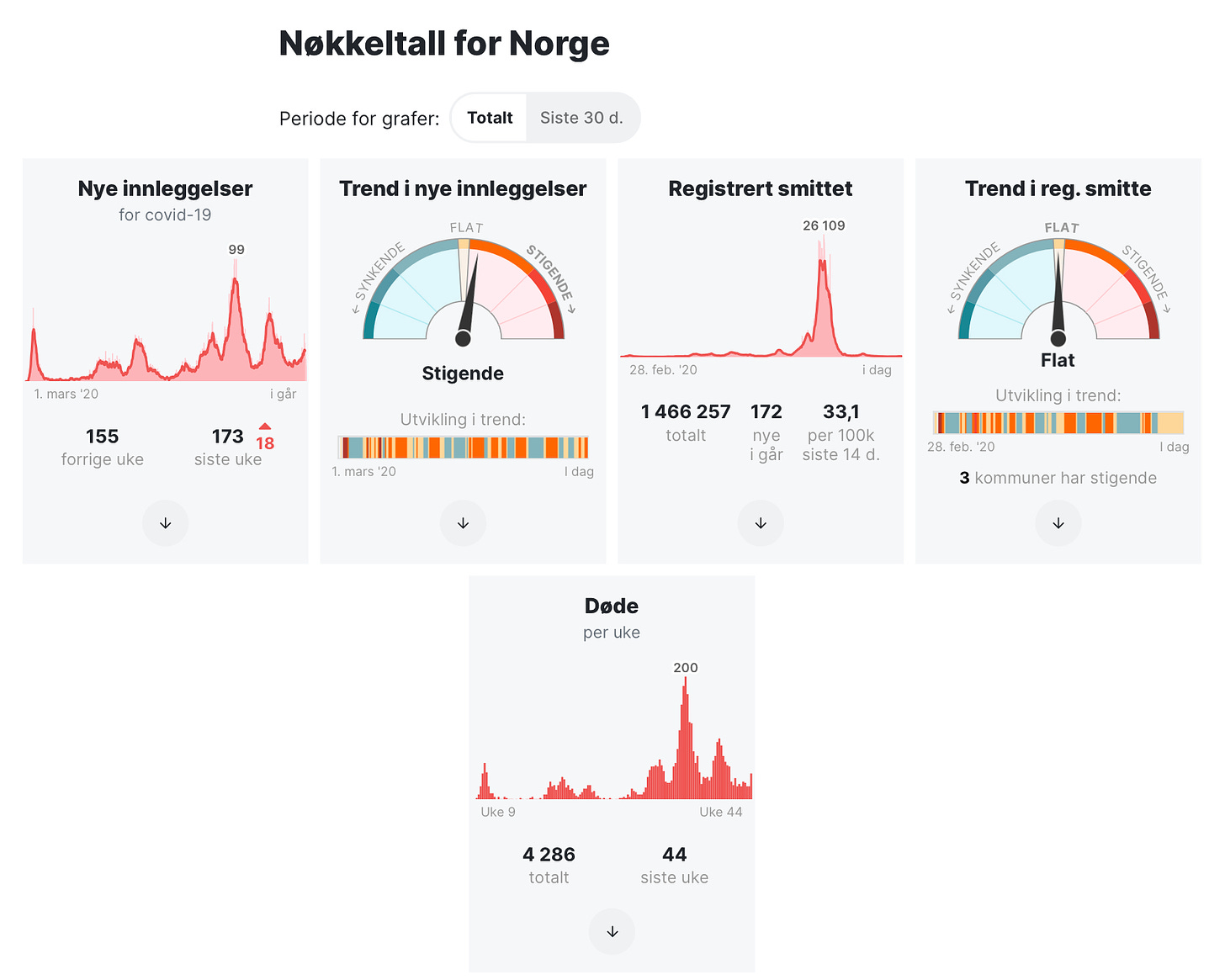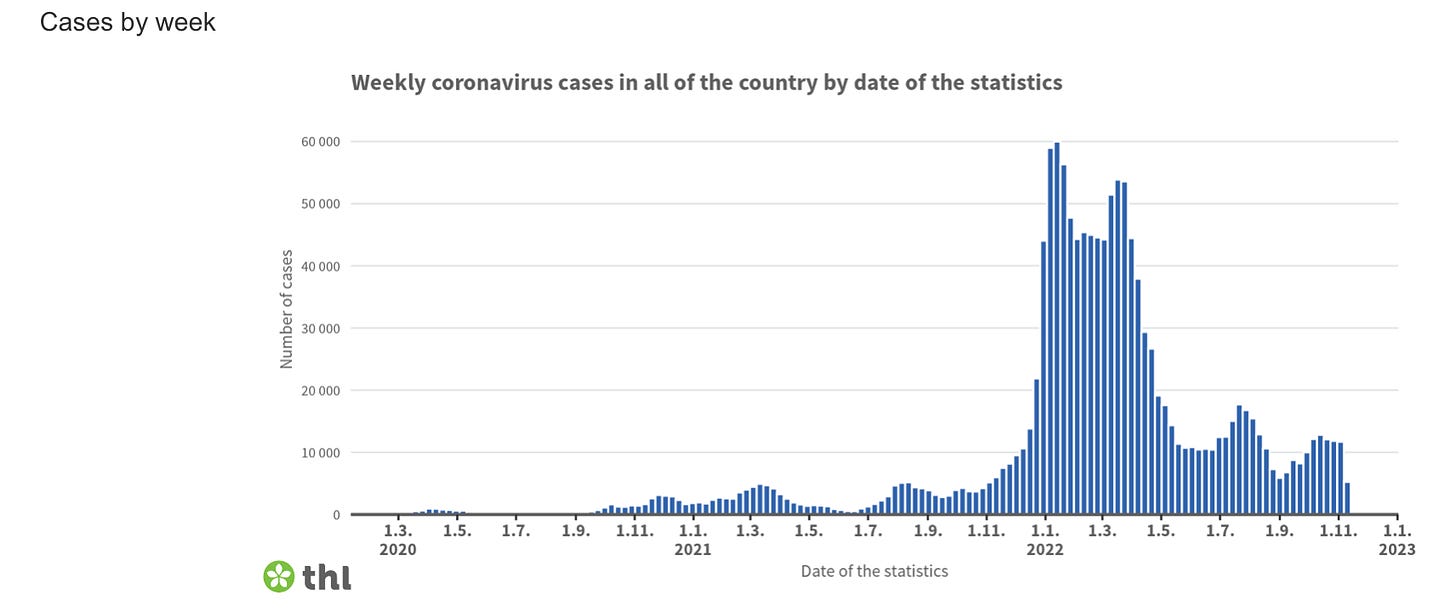🦠Pandemic🦠
🇩🇰
COVID indicators continue to fall in Denmark. For a fourth straight week, the number of confirmed infections, an unreliable indicator, continued to decline according to the latest weekly pandemic assessment from the Statens Serum Institute. But the number of PCR tests taken last week also continued to drop, falling by another 15%. Also down week to week was the positivity percentage going from 14% to 12% last week.
The COVID incidence rate stuck with the trend as it also dropped week to week. Region Sjælland still holds down the highest incidence rate among thrnfive Danish regions with a rate of 91 per 100,000 people. Region Midtjylland has the highest positivity percentage with 15%.
COVID activity across Denmark, as measured by wastewater surveillance, also decreased nationally week to week and across most regions. The exceptions were Region Midtjylland and Region Nordjylland where virus activity remained stable.
Looking at infection numbers by age, COVID cases fell across all age groups last week. The decline in the number of infections was steepest among those 50 years old and older, a clear reflection of the effectiveness of the ongoing booster dose campaign. The COVID incidence rate is now highest among 40 to 49 years old with a rate of 107 per 100,000 people. The positivity percentage has fallen across most age groups, with the exception of those 6 to 15 years old where it remained stable. The highest positivity percentage, 17%, was seen among those 16 to 19 years old.
Among vulnerable seniors in care COVID number dipped almost across the board last week. The one exception was pandemic fatalities, with 9 care home residents passing away due to a coronavirus infection last week; one more death that was reported the week prior. The number of confirmed infections was down and has been steadily declining since week 39. Hospitalizations among seniors in care dropped by half week to week to 11. The positivity percentage also dipped to 2.8% last week. But, the number of PCR tests taken has also fallen again.
Infection related overall hospitalization numbers also dropped for a third straight week. There were 323 coronavirus admissions last week, 139 fewer than the week before. There were just 12 intensive care admissions in week 44. Seniors 70 to 89 years old continue to make up the largest portion of new infection admissions.
Unfortunately, the one number that didn’t go down was COVID fatalities, which remained stable, with 60 more lives lost last week. The total to-date pandemic death toll in Denmark now sits at 7,430 lost lives.
On the variant front, the BA.5 strain, or more accurately, a mix of it and a number of its sub-variants, remains dominant in Denmark. But, the Statens Serum Institute notes the proportion of infections attributed to the group of BA.5 variants is decreasing. As the number of BA.5 cases shrink, the BF.7 (11.31%), BQ.1 (3.08%), and BQ.1.1 (16.20%) variants are gaining ground. The SSI says BQ.1.1 is now “the most frequently occurring sub-variant.” The BQ.1 variant was detected in wastewater sampling for the first time in week 36 and has in the weeks since been detected all over Denmark. In week 43, it accounted for 20% of all identified variants in wastewater testing.
-
COVID hospitalizations (326) continued to drop (-13) while the number of severely infected people in an ICU (13) and of those, the number on a ventilator (5) were both unchanged day to day.
Admissions to a psychiatric facility (64) dipped (-1).
-
Denmark reported 884 COVID infections (underreported), including 417 reinfections, and seven more coronavirus deaths in the last day.
With 8,133 PCR tests taken yesterday, that equals a positivity percentage of 10.86%. Over seven days it is 11.5%.
-
On the vaccination front, to date 29.1% of the total population has a 2nd booster dose. As of last week, 67% of the population 50 years old and older had a 4th dose. Among seniors in care, the vaccination rate was 87.6%. And among seniors 85 years old and older, booster dose uptake was 82%.
-
The Statens Serum Institute sentinel monitoring system for keeping tabs on respiratory viruses found that rhinovirus, RS virus, and enterovirus were the three most commonly detected viruses behind infections other than coronavirus in week 42.
🇸🇪
Sweden added 3,691 infections (wildly underreported) and had another 104 corona deaths since its last update last Thursday.
COVID hospitalizations (679) dropped (-21) ICU numbers (15) were also down (-2).
To date, 88.2% of the population 18 years old and older have one vaccine dose, 86.4% have two, 66.4% have one booster dose, and of those 65 years old and older, 79.7% have a 2nd.
-
The influenza vaccination campaign swung into high gear in Sweden this week, with inoculations beginning on Tuesday. First up to get a flu shot will be people in high-risk groups and healthcare staff. The Swedish Public Health Agency says there is an increased risk this winter of an intensive flu epidemic.
Among those considered to be high-risk moving them to the front of the influenza vaccination line are seniors, pregnant women, and people battling chronic diseases.
A special strengthened flu vaccine will be offered to vulnerable seniors in care. The healthcare agency warns that while it offers better protection, it can also result in stronger side effects like soreness in the arm, fever, or muscle pain.
As in Denmark, Sweden is offering the opportunity for those who are eligible to get a flu shot at the same time as a COVID vaccine booster dose.
Epidemiologist AnnaSara Carnahan:
“It is important that people in risk groups are protected against both seasonal flu and coronavirus, since both viruses can cause severe infections. Vaccination is the best way to protect against severe infection and death for people who belong to a risk group.”
Once the high priority groups are vaccinated the rest of the Swedish population will get a crack at getting the flu shot beginning on December 5.
Carnahan warns that with a lower immunity, and for a larger pool of young children none at all, due to the pandemic all but wiping out two flu seasons and most of a third, there is increased potential for a particularly nasty influenza epidemic this season.
“Influenza, COVID, and other respiratory infections can cause similar symptoms. It is important to stay at home if you feel sick with symptoms such as a runny nose, a cough, a fever, and muscle aches. In this way, we can help reduce the spread of the various viruses that are circulating.”
🇳🇴
In the last 48 hours, Norway has added 336 infections (underreported) and suffered another 48 pandemic deaths.
COVID-related hospital admissions over the last seven days (173) are up (+18).
-
The Norwegian booster dose campaign has managed to get 68% of seniors 75 years old and older a 4th dose. The booster dose vaccination rate falls to 58% for people 65 to 74 years old.
-
In its latest bi-weekly snapshot of the coronavirus situation, the Norwegian Institute of Public Health is warning that another COVID wave appears to be arriving as numbers rise. It is again advising hospitals to prepare for another wave of pandemic patients, outbreaks in healthcare facilities, and increasing numbers of staff calling in sick.
As a matter of fact, COVID outbreaks in healthcare facilities are already increasing, with 33 over the last 14 days. This is more outbreaks in hospitals and other care facilities than in the three weeks before that.
“COVID variants that are better at avoiding immunity are increasing in dominance in Norway and are probably one of the reasons for the increase in infections now.”
In particular, the public health agency says the BA.5 variant is no longer the dominant strain in Norway. Instead, the pandemic picture is now seeing a number of BA.5 sub-variants and an “increasing dominance of different virus variants that have a greater ability to avoid immunity.” Specifically, the NIPH says the BQ.1 variant has increased its proportion of infections in the last few weeks.
COVID wastewater monitoring in Norway, which is limited as it covers an area with roughly 30% of the population, has “indicated a rising infection trend” and has been doing so for four weeks now.
The number of confirmed infections has risen across Norway in each of the last four weeks. There were 499 infections in week 41 and that has increased to 869 last week, week 44.
The NIPH says the number of new hospital admissions directly because of a COVID infection has been increasing for the last two weeks with 270 hospitalizations. There were 150 hospitalizations last week and 120 the week before. Intensive care admissions, on the other hand, have been stable, with seven last week and six the week prior.
The institute says coronavirus-related visits to a family doctor or an emergency room have been slightly increasing in the last two weeks.
Pandemic deaths have also remained stable. There were 44 fatalities last week and another 34 lives lost the week before that.
🇫🇮
Finland registered 11,930 infections and 172 more virus deaths since its last weekly update.
COVID hospitalizations (990) have dropped (-92).
So far, 79.7% of the total population has one dose, 76.7% have two, 54.2% have one booster, and 18.2% have a 2nd.
-
It looks like the Finnish government has found a way to ease tensions between the Finnish Institute for Health and healthcare workers who are angry they aren’t eligible for a COVID booster dose. Finland is the only country in the EU to not include healthcare workers among priority vaccination groups. While the institute has refused to bow to pressure and is standing by its recommendations, it appears there is the possibility for something of a work around.
The Finnish Ministry of Family Affairs Social Services announced this week that it will expand the eligibility of the booster dose campaign. People outside the current target groups who have a doctors recommendation that they should get a 2nd booster dose will be able to do so. And the ministry added that the Finnish regions and municipalities will be able to determine for themselves who is eligible to get boosted. This could open the door to angry healthcare workers.
Minister Krista Kiuru spoke to Yle:
“Municipalities or welfare regions can decide whether to follow the current recommendations of the Institute for Health and Welfare. Although the ministry's COVID working group outlined that vaccines can be provided to people working in the healthcare sector, it's possible that not all providers do so for one reason or another.”
Kiuru also opened the door to a much broader eligibility for a 2nd booster dose sometime in the near future.
🇩🇪
Germany recorded 38,668 new coronavirus infections and had 175 more virus-related deaths.
It saw another 1,613 hospitalizations, while ICU numbers (1,219) have dropped (-67). As a percentage of all the intensive care beds in the country, pandemic patients are using 5.8%.
So far, 77.9% of the total population has one dose, 76.3% have two, and 62.4% have a booster dose.
WHO🌏🦠
Global COVID deaths have dropped like a rock over the course of this year. That is according to the latest weekly pandemic assessment from the World Health Organization. The WHO says its figures show there were 9,400 pandemic deaths around the world last week. In February, the death toll was 75,000.
WHO Director General Tedros Adhanom Ghebreyesus:
“The number of weekly reported COVID deaths is almost 90% lower than in February 2022. We’ve come a long way and this is definitely cause for optimism. But we all, governments, communities, and individuals, need to remain vigilant, including to get the next vaccine dose if it’s due.”
The WHO says new global coronavirus cases dropped by 15% last week. Although it bears repeating due to lackluster testing policies, confirmed infection numbers are extremely unreliable.
Four of the six WHO regions reported decreasing infection numbers led by the European region (-39%). But, in the South-East Asia (+28%) and Western Pacific (+10%) regions numbers were in the rise. COVID fatalities were either stable or in decline in four of the six WHO regions, with the biggest drops in Europe (-40%) and the Americas (-21%). But fatalities rocketed up in South-East Asia (+535%). The global healthcare agency attributes this to batch reporting from India.
Looking at the separate countries and Japan has again seen the highest numbers of any country for new weekly infection numbers with 401,693 infections, a 42% week-to-week increase. While Germany saw the biggest decline with 224,099 COVID cases last week, a 40% drop.
The United States continues to see more pandemic deaths than any country on earth as it lost 2,480 lives (-20%) to the virus last week. India recorded 1,484 deaths, a 2,598% week-to-week increase, again WHO is attributing this to batch reporting.
🇨🇦
The Public Health Agency of Canada only updates national COVID numbers once a week every Friday afternoon.
-
Canadian healthcare officials urged people to take every precaution to prevent the spread of COVID, influenza, and RS virus infections in the winter months ahead.
Chief Public Health Officer Dr. Theresa Tam said in a pandemic update on Thursday that every layer of protection masks to vaccination will help.
“Although no individual layer of protection is perfect, when used consistently and together, vaccine plus layers can provide excellent protection against COVID as well as other infectious diseases we may encounter.”
Tam advised people to mask up when in public indoor spaces and anywhere else where good social distancing is not possible. She also urged people to continue good hand washing habits. Tam says getting up-to date vaccinations are also key, and right now for vulnerable populations in Canada numbers are not where they need to be. She says COVID vaccination uptake among young children is a measly 6.5%.
“If it has been six months since your last COVID-19 vaccine dose or booster, get vaccinated with a bivalent Omicron-targeting booster dose.”
As seen in Europe and elsewhere, Canada is seeing the pandemic move away from seeing one dominant variant take over from the last one. Now, it is a number of coronavirus strains that are ruling the roost.
Deputy Chief Public Health Officer Dr. Howard Njoo says the BQ.1.1 and BF.7 variants are gaining ground across Canada. Even more concerning, he adds that other seasonal respiratory case numbers have already surpassed the usual levels seen at this time of year. Among them, influenza infections are rising fast and already exceed usual numbers. RS virus cases are spiking too.
“At the national level, RS virus activity began to increase several weeks ago, with lab positivity above expected levels for this time of the year.”
Njoo says half of all the infections they are seeing currently are among teenagers and young children. This, combined with a severe national shortage of children’s Tylenol and ibuprofen, has resulted in a flood of children showing up in emergency rooms. Hospitals across the country are straining, and in Ontario many, particularly children’s hospitals, are already over capacity.
Dr. Theresa Tam says work is underway to address the shortage of children’s medicine.
“I do know that our Health Canada colleagues are working extremely hard with different partners, including manufacturers, and that they've also enabled the importation of supplies, such as ibuprofen from the United States and acetaminophen from Australia."
🇺🇦/ 🇷🇺 War
🇫🇮 🇸🇪/ 🇭🇺
Hungary may be playing politics with Sweden and Finland’s NATO applications. Hungary and Turkey are the last two of the 30 NATO member nations who have yet to vote on ratifying, or not, the ascension protocols. The two Nordic countries need a clean sweep from all 30 countries to become full NATO members.
Hungary is currently engaged in a dispute with the European Union. The EU unhappy with Orbán’s cozy relationship with Russia. And due to alleged corruption within his government it has withheld EU funding until the matter is addressed. The European Union has also downgraded Hungary as no longer being a functioning democracy labeling the country instead as an “electoral autocracy.” Being a fully functioning democracy is one of the key requirements for being a European Union member state.
Last week, Hungarian Prime Minister Viktor Orbán personally assured the Finnish President that his country supports the NATO bid and will vote to affirm it next month. Those assurances have been echoed by other government ministers as well. But, Hungary’s government keeps repeatedly delaying the scheduling of the vote in parliament. The current parliamentary session in Hungary ends December 7, making the timeline for a vote next month extremely tight. Hungarian opposition parties are crying foul and accusing the government of trying to leverage Sweden and Finland’s NATO applications in its face-off with the EU.
🇳🇴/ 🇺🇦
Norway plans to inject about 1.5 billion Norwegian kroner (a shade under $200 million Cdn) into a special international fund created to allow Ukraine to buy the weapons it needs directly from the defense industry. Norwegian Defense Minister Bjørn Arild Gram confirmed the news on Thursday. The British government created the fund as a mechanism for western countries to continue arming Ukraine instead of depleting their own inventories of weapons, ammunition, and equipment.
🇳🇱/ 🇺🇦
The Netherlands is also kicking in €100 million (around $136 million Cdn) into the international fund for Ukraine.
🇵🇱/ 🇺🇦
Poland has transferred another 1,570 Starlink satellite internet stations to Ukraine. Starlink is a company owned by Elon Musk of Tesla and now Twitter fame. Ukraine uses the stations both as communications tools to coordinate the movement of its armed forces and to set up the internet in liberated areas so residents can reach the outside world again.
🇸🇪 🇩🇰/ 🇷🇺
Nord Stream AG now has permission to conduct its own investigation into the sabotaged Nord Stream pipelines in the Baltic. The pipeline operator, which is 51% owned by Russian state-owned gas company Gazprom, had previously been able to conduct its investigation into the damage in the Swedish exclusion zone. But, it wasn’t until this month that Danish authorities have allowed the company to venture into the Danish exclusion zone to take its own look. The company is using a vessel chartered from Russia to conduct its investigation.
Two weeks ago, Swedish authorities finished their investigation into the explosions that heavily damaged the pipelines.
Denmark and Sweden have both concluded that sabotage was behind the explosions, but neither country has said who they think is to blame.
🇳🇴/ 🇷🇺
A Russian man has been officially charged after he was caught filming potentially sensitive sites in Norway with a drone. The man is his 30s, will face charges for flying the drone and filming in a total of seven sensitive locations. He will appear in court on November 15.
This will be the first such case to go to court in Norway testing new national security rules put in place after Russia’s invasion of Ukraine, but it won’t be the last. Later this month, three other Russians will also face trials after being charged with flying a drone to film in sensitive locations.
















